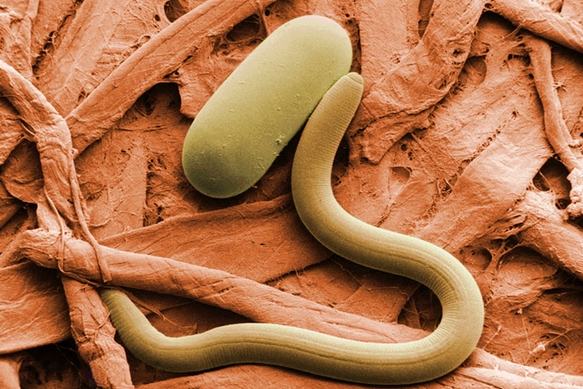
Advertisement
When 22-year-old Neha Begum of northern India began suffering from chronic stomach pain, constipation, and vomiting, she naturally went to visit the doctor. But no matter how many times she visited, doctors were unable to diagnose her problem. Rather than trying to find and fix her obvious health problems, they instead told her to take painkillers. When she had a particularly severe attack, she decided to travel to a larger hospital instead.
“When we examined her, we found something was obstructing her intestines. So we decided to open her stomach and see what was causing the obstruction,” said Dr Anand Prakash Tiwari. “We were shocked to find live round worms wrapped around her intestines and pulled out more than 150 of them alive. I was shocked. This was an extremely unusual case.” The worms removed from Begum’s gut were up to 25 cm (10 inches) long.
Completely unheard of
“I was in extreme pain for weeks,” Begum said. “It was awful. I suffered so many sleepless nights and I used to scream in pain and vomited. But now it’s like I have a new life.”
Tiwari blamed poor living conditions for Begum’s infection, suggesting that she likely ingested the parasitic eggs from water or raw produce contaminated with fecal matter. Yet while such infections are relatively common in India and can even occasionally lead to intestinal obstructions, Tiwari expressed shock at the sheer number of worms extracted from Begum’s body.
Prior to this case, the most worms Tiwari had ever extracted from an obstructed intestine was three or four. The doctor said that Begum was lucky that the infection was discovered before it became even more severe and the parasites migrated to the brain, causing permanent brain damage. Indeed, just one week after the operation Begum was recovering well and able to eat solid foods.

Profile of a parasite
Although media reports were unclear about exactly what parasite Begum was infected with, her case closely matches the profile of a roundworm infection, albeit of a severity nearly unheard of.
Roundworm infection comes from consuming food or water contaminated with roundworm eggs from human feces. It is common in tropical and subtropical parts of the world with poor public sanitation systems. Roundworms can reach 30 to 35 cm in length and are the only earthworm-sized parasites that can be found in human feces. While most cases are asymptomatic, with the potential exception of a high temperature and dry cough between four and 16 days after initial exposure, about two out of every 1,000 cases result in an intestinal obstruction. Other complications can be caused by the worms migrating to other parts of the body.
The roundworm life cycle is as remarkable and unsettling as the idea of 150 of these parasites in your intestines. The eggs only hatch after being swallowed. The tiny larvae then pass through the walls of the intestine and into the blood, migrate to the lungs, then crawl between the cells of the respiratory system until they reach the throat — where they are then swallowed again! This time they land in a different part of the intestine, where they grow to their adult size and start laying up to 200,000 eggs a day.
Roundworm infection, also known as ascariasis or ascaris, is considered a major public health problem.
Roughly one-quarter of the world’s population is currently infected by a soil-transmitted parasitic worm, of which roundworm is one of the most common.
Emerging research suggests, however, that there may be a positive component to parasitic infection. Some scientists believe that due to a long history of co-evolution, the human body has come to depend on the mild immune-suppressing effects that parasites generate to protect themselves. Without parasites, these researchers suggest, humans are significantly more vulnerable to autoimmune disorders from allergies and asthma to rheumatoid arthritis and multiple sclerosis. Some parasites may also help filter heavy metals and other toxins from the body.
Sources:
Submit a correction >>
This article may contain statements that reflect the opinion of the author
Advertisement
Advertisements















